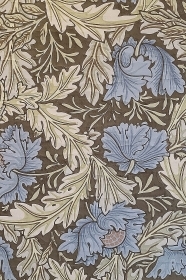Hanging on the walls at a house in Hammersmith
FACING THE THAMES near to The Dove pub in Hammersmith, there is an interesting little museum dedicated to exhibits relating to William Morris. In my book “BEYOND MARYLEBONE AND MAYFAIR: EXPLORING WEST LONDON”, I wrote about the museum as follows:
“ … Kelmscott House. Built on the site of an old warehouse, this became the home of Sir Francis Ronalds (1788-1873) in the early 19th century. Sir Francis, an inventor, laid eight miles of insulated electrical cable in the house’s extensive garden, which in his time stretched as far inland as King Street, and with that he demonstrated the use of telegraphy for the first time in history in 1816. When he reported his discovery to Lord Melville, the First Lord of The Admiralty, he was told (by Melville) that telegraphs were totally unnecessary, because the semaphore did the job of communication just as well.
In 1878, Ronalds’s house, known then as ‘The Retreat’, was bought by the writer and artist William Morris (1834-1896), who was a leading exponent of the Arts and Crafts Movement and a social reformer. According to his biographer Fiona MacCarthy, Morris did not like its name because ‘Retreat’ suggested that it might be regarded as an asylum. So, he renamed it Kelmscott House (the name of Morris’s Thames side dwelling in Oxfordshire).”
I wrote that the museum is housed in the:
“… long narrow coach house attached to the west side of Kelmscott House which was used as a lecture hall in William Morris’s time. It hosted many meetings of groups sympathetic to socialism, including one that which Morris joined in 1883: the ‘Democratic Federation’, later known as the ‘Social Democratic Federation’. Like some of today’s leading British socialists, Morris was also far wealthier than the people whom he hoped to help with his left-wing political sympathies.

Today, the coach house, which bears a plaque in memory of Sir Francis Ronalds, houses the offices of the William Morris Society and a small museum.”
Recently (June 2024), we visited the museum, which has a temporary exhibition called “The Art of Wallpaper: Morris & Co. in Context”. It will remain in place until the 11th of August 2024. According to the museum’s website (https://williammorrissociety.org/whats-on/):
“This exhibition focuses on William Morris (1834–1896), placing his wallpaper designs within the context of the radical changes in taste witnessed during the Victorian era. His distinctive patterning is set against a backdrop of the fanciful, naturalistic patterns that typified fashionable English and French papers in Morris’s youth.”
The visitor can admire a collection of framed, highly decorative wallpaper samples, including many designed by Morris and his associates. Apart from the Morris designed wall papers, there are examples of styles that were fashionable in the 19th century: French style, Reform Movement Styles (e.g., by Pugin), Japanese-influenced designs, and the Arts and Crafts Movement. The most interesting exhibit was a wooden printing block, which would have been carefully inked up in different colours, and used to create the wall papers. Next to this, there were a couple of pages from the Morris logbook used to record the colours and designs of the papers produced by Morris and his company.
The small museum is well worth a visit. It is a shame that the main house to which it is attached is not open to the public at present.
PS The book is available as a paperback and a Kindle from AMAZON



